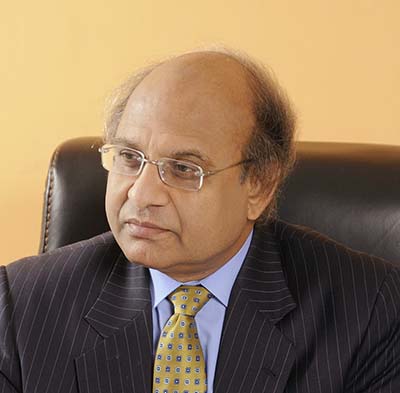Narratives asked three top experts – former finance ministry advisor Dr. Ashfaque H. Khan, former SBP advisor Zafar M. Shaikh and Samiullah Tariq, head of research at Pak-Kuwait Investment Company – to give their views on this month’s Big Question.
The Pakistani rupee slumped to record lows against US currency by the end of September, despite growing foreign exchange reserves and increased economic activity. The State Bank of Pakistan (SBP) allowed the rapid rupee depreciation, unleashing uncertainty in the markets, hurting investment and business sentiment and increasing the country’s mountain of debt without any fresh borrowing. Is SBP’s inaction amidst the falling rupee the right policy?
Hurting the economy

Dean and Professor, National University of Sciences and Technology (NUST) Former advisor, Ministry of Finance.
There was no need at all to depreciate the Pakistan rupee against the US dollar over the past four months. The economy was performing well. It grew by close to 4 percent in the previous fiscal year 2021. Foreign exchange reserves stood high at $15.77 billion in May that surged to record a high over $20 billion in August. The private sector had come forward to invest and exports were gaining momentum.
However, some people within the government did not like Prime Minister Imran Khan having steered the economy in the right direction through the third year of his government during FY21. It was the central bank and its top leadership that deliberately depreciated the rupee, despite the fact that the country’s foreign exchange reserves were on the rise.
Depreciation in currency at times of surge in forex reserves is against the principles of economy. There was no economic justification for devaluation in rupee when the FX reserves were growing. The central bank, however, depreciated the domestic currency after it was prevented from increasing the discount rate. The depreciation in rupee created inflation and the central bank achieved building a case for surge in discount rate after 15 months in September. All such measures by the central bank have once again started derailing the economy, as the measures increased cost of doing business and cost of living, particularly for poor segments of society.
The value of rupee stood at Rs. 152.28 for a dollar on May 7, 2021 and it was dropped by around Rs. 11 since then to Rs. 163 on August 5. The Afghanistan crisis that is being presented as a case for further depreciation in the rupee-dollar exchange rate these days had not emerged before August 5.
The rupee has lost a total of Rs. 18 to close to around Rs. 170 on September 28 compared to Rs. 152.28 on May 7. The significant depreciation has added foreign debt and interest payments on the debt by a total of Rs. 1,722 billion without borrowing a single dollar. The central bank’s top leadership is responsible for adding this burden.
The government is very touchy about inflation. The devaluation by definition is inflation. All the landed cost of industrial input will go up. At the same time, the government is increasing power and gas prices. So Pakistan’s industry is bound to become uncompetitive in international markets. This will be damaging for the country’s exports.
The central bank has increased the discount rate by 25 basis points to a 15-month high at 7.25 percent on September 20 and it is set to further increase in the next monetary policy statement. An increase of 1 percent in the discount rate increases inflation by 1.3 percent and surges interest payments by Rs. 180 billion.
If the discount rate keeps increasing, than the time is not far off when all the federal receipts – after paying provinces under the NFC award – would go into paying interest money and the entire defence spending would be financed through borrowed money. What kind of national security would we have? The defence budget is already being financed 50 percent through borrowed money.
I have been consistently saying for the last three years that please pursue an aggressive and yet selective import compression policy. Discourage non-essential import and save dollars. For three years in a row, nobody listened. When a lot of water has flown under the bridge the government appears to have woken up and decided to impose 100 percent cash margins, regulatory duty, and discourage import of non-essential goods.
The current account deficit is heading towards the worst hit level of 2017-18 and that will build a case for another IMF programme in September 2022. This will be the last nail in the coffin of Pakistan’s economy.
This is the central bank and its top leadership which is giving the biggest challenge of high inflation to the government through rupee depreciation and discount rate hikes. How will this government go and ask for votes in the next elections with unprecedented hikes in essential commodity prices like wheat flour and bread?
Unnecessary Depreciation

Former Advisor to Governor State Bank of Pakistan on Foreign Exchange and Debt Management (2001-2005).
Authorities concerned have let the rupee lose its value against the world’s major currencies, including US dollar instead of putting in place measures to stabilise the domestic currency in the greater national interest.
The rupee has depreciated to unrealistic and record lows close to Rs. 170 per US dollar, compared to around Rs. 105.50 in early December 2017 when Pakistan started preparing to acquire the ongoing IMF loan programme worth $6 billion.
The unnecessary depreciation has made imports expensive and exports uncompetitive, and created high inflation that badly hit businesses and households, particularly small and medium-sized enterprises (SME) and low-income groups, and growing debt. The mismanagement of such highly important economic affairs would slow down economic activities and make growth unsustainable.
An undervalued rupee is a sleeping pill for exporters and a wake up call for importers. Pakistan’s exports heavily rely on import of raw materials, oil and gas, plants and machinery. Accordingly, expensive imports in the wake of the weakened rupee have made exports uncompetitive. Exporters earn through value addition in raw material. A weaker rupee and costly import of raw materials have narrowed exporters’ profit margins and hindered growth in exports. The rupee depreciation-driven expensive imports have also pushed up the price of essential goods produced for local consumption, inviting new waves of inflation.
The rupee should be trading around Rs. 120-130 against the dollar in the inter-bank market and the benchmark interest rate should be around 4-5 percent not 7.25 percent. Economies around the world including Japan, Germany and other European nations have cut interest rates to zero to support growth. On the contrary, Pakistan’s central bank jacked up the rate by 25 basis points to 7.25 percent on September 20. The increase in the rate would by no means achieve the desired target of reducing imports, but would contribute towards inflation.
The forex reserves are hovering around record high levels at $19.5 billion these days. They allow economic managers to inject dollars in the inter-bank market to support the rupee and buy foreign currency from the market when available at a cheaper price.
The State Bank of Pakistan (SBP) had done so during 2001-2005 when the bank was left with only one-week import cover, meaning the foreign exchange reserves stood at $800 million at that time. Despite the situation, the SBP put measures in place and succeeded in appreciating the rupee by Rs. 4 to Rs. 60 against the dollar from Rs. 64 and did not let the country default on any payments.
In those days, the SBP received a call from Pakistan State Oil that they required foreign exchange to pay for import of oil, which was trading at $150 per barrel at world markets. The central bank successfully arranged the payment through partially buying dollars from the market and partially paying from the reserves. Despite other such payments, the SBP reserves reached $6 billion later on.
Today, oil is available at half the price at $75 per barrel and the reserves are enough for over three-month import cover, but the rupee has been devalued to record lows, embroiling Pakistan in a crisis. The trade deficit is not accumulated in one day or one week, but needs weeks and months. Accordingly, buying and selling dollars by the central bank from the inter-bank market may still help to manage reserves on higher side and make international payments smoothly.
IMF conditions do not prevent the State Bank from playing fair at the inter-bank market, meaning it may buy and sell dollars to maintain a sustainable supply and demand situation of foreign currency in the market.
Apparently, managers in lead positions lack the will and courage to take out of the box solutions today and are following Western formulas. This is Pakistan and not the US. It needs out of the box solutions to run the economy smartly. For example, the government should launch dollar denominated national savings certificates and bonds for development projects. The strategy would support building foreign exchange reserves and reduce the country’s dependence on the IMF in the future.
Growth to Continue

Research Head Pak-Kuwait Investment Company.
The downward adjustment in Pakistan currency against the US dollar was the need of the time to create a balance between rising demand and relatively low supply of foreign currency in the domestic economy. The adjustment has improved the country’s balance of payments – the difference between international payments and receipts – a must to ensure sustainable economic growth to the next high level.
If the domestic currency had not taken the route to cool down demand for dollars, then the widening gap between the foreign currency’s demand and supply would have taken the country back to crisis times like the one witnessed in fiscal 2018. The year saw the high import payments and debt repayments devour most of the then forex reserves which dropped to less than two-month import cover at around $7 billion. The current account deficit widened to a record high at $20 billion. The situation compelled a return to the IMF to acquire the ongoing loan programme worth $6 billion on stringent conditions.
The local currency rebalanced after import payments hit a record high of $6.4 billion in August in the wake of recovery in demand for imported goods in the domestic economy, and commodity prices rose sharply in the global markets.
On the other hand, the foreign currency supplies remained comparatively low despite strong inflow of workers’ remittances from overseas Pakistanis, receipt of additional unconventional remittances from them through Roshan Digital Accounts (RDAs) and improved export earnings.
Accordingly, Pakistan currency gradually reversed all the gains achieved against the US dollar in the middle of the ongoing Covid-19 pandemic, surpassed the previous record low of Rs. 168.43 and further decreased to a new low at Rs. 169.96 to hit equilibrium against the foreign currency in September.
Earlier, the domestic currency saw the previous all-time low of Rs. 168.43 some 13 months ago in August 2020. Later on, it recovered 9.6 percent to the then 22-month high of Rs. 152.27 in May 2021.
The recovery was seen in the middle of the pandemic when import-driven demand for dollars had dropped due to closure of global economies and decline in world commodity prices.
The latest drop in the rupee is not going to derail Pakistan from accelerating its economic growth to the next level. The country’s economic fundamentals stand strong and support achieving the set economic growth target of 4.8 percent in the ongoing fiscal year 2021-22, compared to 4 percent achieved in the previous fiscal year 2020-21.
Pakistan’s central bank said on September 20 that the economy was recovering at a faster pace than expected. This suggested the economy had started overheating and required measures to be cooled down to the required level. That’s why the State Bank of Pakistan (SBP) enhanced the benchmark interest rate by 25 basis points to 7.25 percent, and government increased import duty of non-essential goods, including luxury cars. The measures would create a balance between growth and available resources. The measures would also help the rupee to consolidate around current levels.
The state has ended its control over rupee valuations. Now, there are the market forces (mostly commercial banks) that determine its value, keeping in view the demand and supply situation of the foreign currency in the system. Thus, the rebalancing act in the rupee is done through the flexible rupee-dollar exchange rate mechanism both ways (up or down). And the central bank still holds power to intervene, like supplying dollars or mopping up from the inter-bank market to address imbalances and give a direction to the rupee in accordance with the economy’s trajectory.
The flexible mechanism has partly played its critical role in taking the country’s foreign exchange reserves to all-time high above $20 billion in August. Artificially holding rupee at over-value, which is not the case at present, would have taken the reserves back to the 2018 level.
In July, the central bank projected the current account deficit would widen to 2-3 percent of GDP (gross domestic product) in the ongoing fiscal year 2022, compared to a 10-year low of 0.6 percent in the previous fiscal year 2021. The projected increase in the deficit was measured keeping in view the outlook for higher import payments and to support the economy growing by 4-5 percent in FY22.



